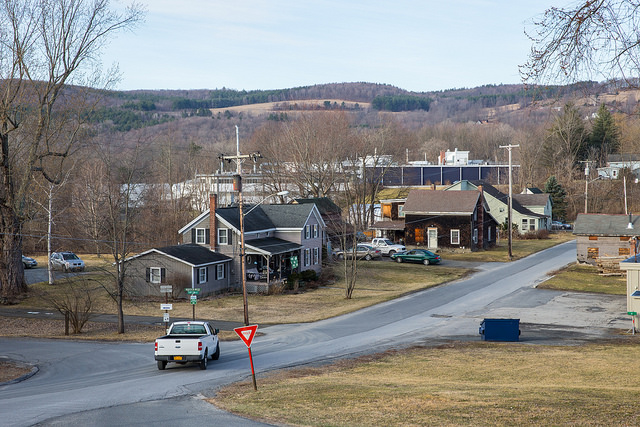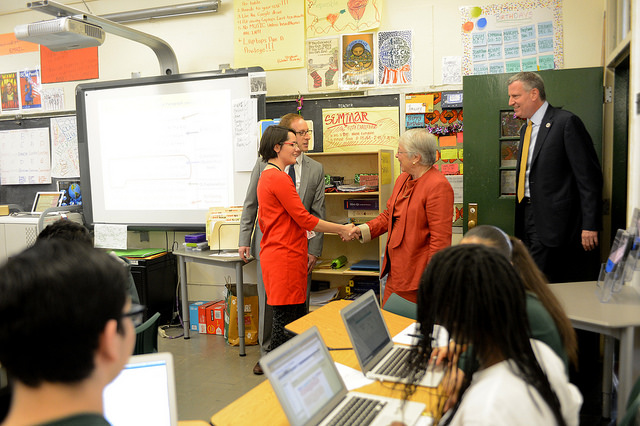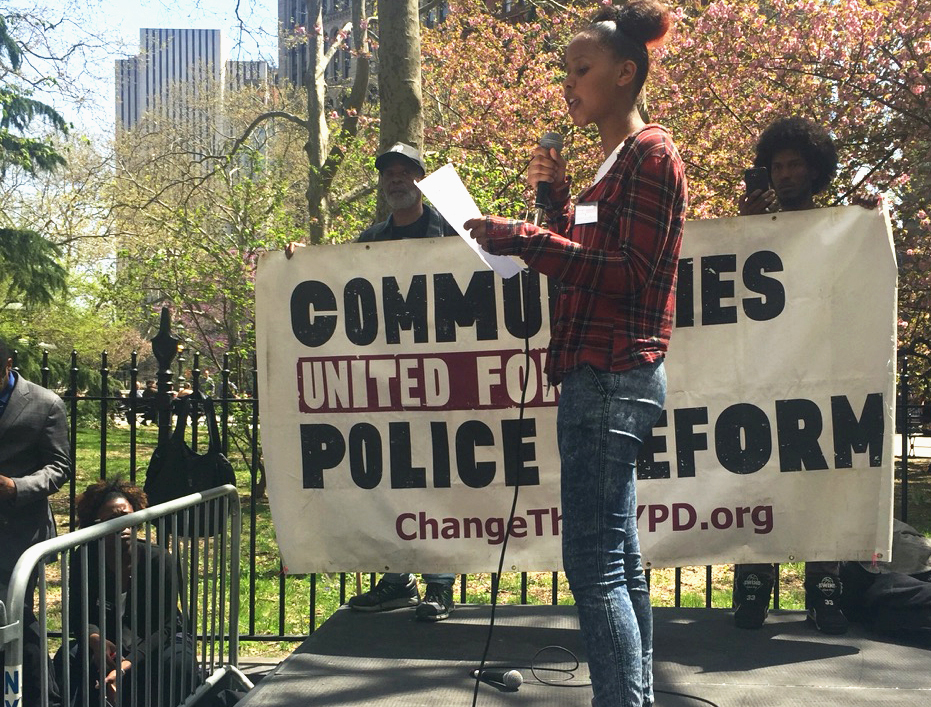Hoosick Falls Residents, and All New Yorkers, Deserve Water Contamination Hearings

Hoosick Falls (photo via The Governor's Office on Flickr)
Just imagine knowing that the water you are drinking is quietly making you sick. That it gave you or someone you love kidney cancer. That it took years to get your government to listen, then when you got its attention, your concerns were downplayed.
The bond between clean water and our health has been broken as we’ve heard stories state- and nation-wide about contamination. And like Flint, Michigan, there is a great disconnect between the suffering of Hoosick Falls, New York residents and the actions (or in this case, inaction) of their own elected officials. Hoosick Falls residents are just 30 miles from the steps of the state Capitol in Albany, but that may as well be a million miles given the response from the people elected and hired to protect them.
State lawmakers should hold hearings on what has happened in Hoosick Falls and the flawed state reaction to the water crisis there. Governor Cuomo and his top officials should welcome hearings as a chance to show New Yorkers that they want to get to the bottom of the issue, protect constituents across the state, and that they will not make the same mistakes again. There are some who disagree, but they are wrong, and here’s why:
Hoosick Falls residents deserve to know what happened, and who knew what and when. Further, lawmakers cannot ignore that what has happened in Hoosick Falls is not limited to just that village. Grossly inadequate chemical regulations on the books in New York, coupled with an increased hunger by state Senators to “cut the red tape” (which translates into cutting resources and powers for enforcement of our laws) means that it is only a matter of time before another community is fighting another unregulated chemical which has fouled their water.
Hoosick Falls is like many New York communities, particularly upstate, with an extensive manufacturing history.
For decades, industries were allowed to operate virtually unchecked as their operations endangered residents. For many years, contaminations of this kind were seen as affecting other communities home to larger companies. General Electric, for instance, spent decades dumping PCBs into the Hudson River, up until the late 1970s. Meanwhile, outside Syracuse, Onondaga Lake became known as the most polluted lake in America after a century of pollution from predecessors of the very same company associated with Hoosick Falls contamination: Honeywell.
A lack of regulations and enforcement created a false sense of security for many communities – after all, if a chemical isn’t regulated, it’s not tested. And if it’s not tested, then how does anyone know if it’s in their water and affecting their health?
In May, when the federal Environmental Protection Agency (EPA) issued new safety levels for PFOA and PFOS, many localities suddenly found themselves with unsafe drinking water. Of course, the water had been unsafe for many years – but if no one knew to test for it no one knew there was a problem.
Since the crisis in Hoosick Falls became public, PFOA has been found in the drinking water of nearby Petersburgh, a community also now home to a Superfund site. PFOS has also been found in the City of Newburgh’s water; water in Suffolk County also exceeds safety levels.
Which brings us to the realities of today, and the unique role that state legislators have in holding hearings - public reckonings that help clarify what can and should be done to help people. Currently, there are more than 80,000 untested and unregulated chemicals on the market. The state Department of Environmental Conservation (DEC) has introduced emergency rules regulating PFOA and PFOS, but there are still tens of thousands of chemicals unaccounted for.
Resistance to legislative hearings is a head-scratcher. We’re pleased to hear that the Assembly has reopened the door to hearings; they should have occurred as originally planned following passage of the 2016-17 budget, which occurred April 1. This summer is now the time to follow through - no further delay is acceptable. These hearings should not be scuttled, the issues facing the people of Hoosick Falls and other municipalities must be seen in the light of day. It is legislators’ responsibility.
Hearings are a part of governmental checks and balances. Witness how rapidly the Senate rushed to hold a hearing on how to keep communities from imposing a fee to curb costly plastic bag waste. A public health crisis certainly deserves more proactivity than we have seen. Instead, the Senate is advancing a package of bills toward a vote that would exacerbate the very problems resulting from poor oversight and enforcement. In fact, one proposal forces agencies to enact a “one-in, one-out” practice when imposing new rules. In other words, when the DEC finalizes its PFOA rule, they would have to cut a regulation for the benefit of Honeywell International and Saint-Gobain, the companies responsible for the Hoosick Falls contamination.
The action that legislators take now will have enormous consequences for years to come. They must use their expertise in local affairs toward addressing their constituent concerns and public health hazards. The goal should be to consider contamination issues from across the state to connect the dots and create a game plan that modernizes our regulations and enforces our laws. New Yorkers must have confidence in both their drinking water and their elected officials.
Residents of Hoosick Falls and many other locales would be glad to hear that their elected officials are working throughout the summer to protect our water and our health. It’s an opportunity lawmakers should not pass up.
***
By Liz Moran, Water & Natural Resources Associate, Environmental Advocates of New York. On Twitter @greenwatchdogNY.
***
Have an op-ed idea or submission for Gotham Gazette? Email This email address is being protected from spambots. You need JavaScript enabled to view it.
Advanced Placement Expansion Means Opportunity for All

photo: Rob Bennett, Mayor's Office
Education is a democratizing force. As we work to build a more equitable and even stronger public school system and city, it is our responsibility to ensure all our students – regardless of where they attend high school – are prepared to enter and graduate college.
As a lifelong Hunter student, I have been the beneficiary of tremendous good fortune through access to high quality education, and I feel compelled to pay it forward. I am grateful that my parents knew the benefits of a Hunter education early on, but this awareness is far from universal. I founded Promoting Access to Specialized Schools in New York City (PASSNYC) chiefly to tackle the lack of awareness of the admissions process and opportunities afforded by the city’s specialized high schools. At PASSNYC, we believe that educational access and achievement are paramount in creating a more just and progressive society.
These schools offer some of the most transformative opportunities for students from all socioeconomic backgrounds. Yet, PASSNYC’s work recognizes that there will never be enough seats for all of the talented students that would benefit from attending.
Advanced Placement courses are powerful tools that serve talented students and help them make the most of their college experience. AP courses engage our high school students and allow them to explore subjects in depth, but most importantly, research shows that they prepare students for the rigors of a college education. An AP class on a student’s transcript makes their college application more competitive. AP exam credits often count toward degrees, allowing students to graduate faster and with less debt.
Unfortunately, outside of the specialized high schools, many students lack access to AP classes and support for AP exams. Citywide, there are still over 100 schools that lack AP courses, and many more that don’t offer a full slate of APs, especially in the all-important STEM subjects. These schools disproportionately serve low-income and black and Latino students.
The de Blasio administration’s new “AP for All” initiative aims to change that by giving all New York City students access to at least five AP classes by the fall of 2021. Monday’s announcement of the first AP for All expansion is welcome news: 63 high schools will offer new AP courses next school year, including 35 that don’t currently offer any AP courses at all.
At Hunter College High School, I was surrounded by some of the most ambitious students the city has to offer. In this environment, it was not unheard of for a single student to earn a top score on seven AP exams before graduating. I have seen firsthand how the challenge of AP courses brings out a level of drive and motivation that can power students through the course and on to college. Many of my former classmates are most thankful for their high school AP teachers, citing them as essential to their current success. In hindsight, it is remarkable how much I was offered and took for granted.
We can’t afford our bright young minds missing out on opportunities that put them on the road to enrolling and succeeding in college – or that can spark the passion to become an engineer or a doctor – just because of their neighborhood.
AP for All will give more students in need the means to demonstrate their potential and talents, starting with thousands getting new opportunities across 63 high schools next year.
PASSNYC is aligned with the City’s approach to focus support on both teachers and students.
As AP for All expands to reach every high school across all five boroughs, more New York City students than ever will be equipped with the resources, knowledge, and confidence to succeed as college students and face the challenges that lie ahead.
***
Ryan Baxter, founder and chairman of PASSNYC, a not-for-profit, volunteer organization dedicated to broadening educational opportunities for New York City's talented underserved students. On Twitter @PASSNYCorg.
***
Have an op-ed idea or submission for Gotham Gazette? Email This email address is being protected from spambots. You need JavaScript enabled to view it.
Time for Restorative Justice in Our Schools

Zaire Kiran Agostini, the author
Being a black girl in New York schools is hard—the stereotypes and biases we face are painful, and often overlooked. Too often, they lead to suspensions and arrests of young people like me that take us out of school and push us toward the streets, prison, or worse. Now is the time for New York State to take action to address the damage being done by out-of-touch school discipline policies.
When teachers or administrators look at girls like me talking with my friends, they look at us like we are always about to cause trouble. If we speak up for ourselves, they say we’re being defiant. Even when we are having fun together, like joking around and dancing, they view our behavior as inappropriate. And then, too often, they discipline us.
Youth of color are treated differently than white youth across our state, and data proves that is a reality. Black girls in sixth to eighth grade in New York City, for instance, are eight times more likely than white girls to be suspended two or more times. Being black is the biggest indicator that you will be suspended or arrested in school. Latino students are also more likely to face harsh discipline.
The majority of suspensions and criminal summonses are not for violent and dangerous reasons. They are for minor infractions like “defying authority” or “disorderly conduct”—infractions that the Department of Education’s Office of Civil Rights acknowledged can be biased and unfairly impact students of color.
In school every day, the first thing that greets us is police officers and a metal detector. It’s demoralizing and, for many of us, can be traumatizing. Once inside the building, students like me face stereotypes that we will never graduate, that we will drop out and have a child, that we are trouble waiting to happen. It feels like the system isn’t built to build us up and support us, but to break us down mentally and emotionally. Research shows the presence of police leads only to an increase in students being arrested for minor incidents. Instead of investing in students, our state is investing in the school-to-prison pipeline. And it’s time for that to change.
Assemblymember Catherine Nolan has introduced a school discipline bill that would make a real difference for students like me. Her proposal, which just passed the State Assembly’s Education Committee, will help to sustain healthy and inclusive learning environments by encouraging schools to approach discipline using restorative practices and ensure fair and equitable discipline for all students, especially students of color and students with disabilities. This restorative justice approach—which engages constructively with young people and limits ineffective measures like suspensions and expulsions—has been tried successfully in schools across New York City and is now being expanded with support from the City Council.
The State must embrace restorative justice and positive discipline strategies, too. The first step: with momentum coming out of the Education Committee, the New York State Assembly should pass the Nolan bill, and send a strong message to the state Senate and Governor Cuomo that we must embrace a bright future for young people like me.
***
Zaire Kiran Agostini is a youth leader with Make The Road New York and the Urban Youth Collaborative. Follow their work on Twitter: @MaketheRoadNY @UYC_YouthPower.
***
Have an op-ed idea or submission for Gotham Gazette? Email This email address is being protected from spambots. You need JavaScript enabled to view it.




